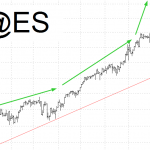Immediately after the Fed hiked interest rates last Wednesday – after sitting at 0% for 7 years – markets acted pretty much as one might expect. The Fed tightens monetary policy when the economy is strong so rising stock prices, rising interest rates and a strong dollar are all things that make sense in that context. I am sure there were high fives all around the FOMC conference room. Too bad it didn’t last more than one afternoon. By the close Friday, the Dow had fallen nearly 700 points from its post FOMC high, the 10 year Treasury note yield dropped 13 basis points, junk bonds resumed their decline and the dollar was basically unchanged. Not exactly a ringing endorsement of the Fed’s assessment of the US economy.
I’m not saying the Fed’s rate hike is what caused the negative market reaction Thursday and Friday. The die for the economy has likely already been cast and right now it doesn’t look like a particularly promising roll. Raising a rate that no one is using by 25 basis points is not the difference between expansion and contraction. And a bit over a 3% drop in stocks isn’t normally much to concern oneself with; a 700 point move in the Dow ain’t what it used to be.
The pre-existing conditions for the rate hike were not what anyone would have preferred. The yield curve is flattening, credit spreads are blowing out and the incoming economic data is not improving. Inflation is running at a fraction of the Fed’s preferred rate and falling oil prices have been neither transitory nor positive for the economy, at least so far. The Fed is not unaware of this backdrop – they may not like it or acknowledge it publicly but they aren’t blind – but seems to have decided the financial instability consequences of keeping rates at zero longer are greater than any potential benefit. A sobering thought that.
The stock market drop, the rally in Treasuries, the falling commodity prices, the rout in the junk bond market – none of these are particularly new developments and the Fed’s action last week changed none of them for longer than a few hours. The stock market, in case you missed it, peaked almost 18 months ago and the average stock is already nearing bear market territory regardless of what the averages might say. The 10 year Treasury yield is unchanged in the last year, something that seems impossible considering all that has happened in that time. The path to those unchanged levels was a roundabout one – volatility is up about a third from last year – but the message is pretty clear. If economic growth was expected to accelerate bond yields would be higher. If corporate earnings were expected to rise, stock prices would be higher.














Leave A Comment